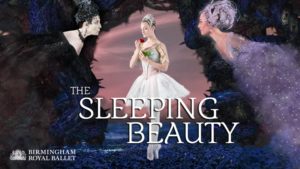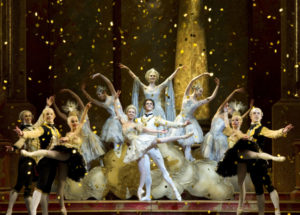 (4 / 5)
(4 / 5)
Music: Pyotr IlyichTchaikovsky
Choreography: Marius Petipa, Lev Ivanov, Peter Wright
Production: Peter Wright
Designs: Philip Prowse
Lighting: Mark Jonathan
Re-created by Peter Teigen
The Sleeping Beauty is probably the best classical ballet in the world. It has more famous tunes than any other, so with great anticipation I attended at the WMC to witness the Birmingham Royal Ballet’s lavish production of Tchaikovsky’s masterpiece.
The BRB has a long connection with this work. As long ago as 1949. the eminent ballet critic Richard Buckle was commenting on this, although he referred to a production by the Sadler’s Well Ballet , the company that evolved into the BRB in 1990. Today, together with the Royal Ballet and the English National Ballet, the BRB completes the “Big Three” ballet companies in the U.K, so you know that a quality production will be on show.
We all know the story. In the palace, the King and Queen await the christening of their only child Princess Aurora. All the fairies are invited to the ceremony and are to be godmothers to the princess. However, Carabosse, the ancient Fairy of wisdom, seems to have been on extended leave and hadn’t been seen for years, so she is not invited. The fairies, led by the Lilac Fairy, arrive and present their gifts, but then, spurned Carabosse and her gang of evil fairies turn up and lay a curse on the princess, saying that on her sixteenth birthday, she will prick her finger on a spindle and die. All is not lost because the Lilac Fairy, although being unable to remove the curse, issues a counter spell whereby Aurora will not die, but fall into a deep sleep, even longer than the semi-comatose state that I find myself in after consuming a bottle of Malbec! In fact, the only thing that will awaken her up is that a prince who truly loves her will plant a kiss on her. Right on cue, at Aurora’s sixteenth birthday do, Caraboose, in disguise, tricks her way into the celebrations and presents the poisoned spindle to Aurora, who captivated by something she hasn’t seen before, dances with it, but is then pricked with the potentially fatal poison and collapses. Step in the Lilac Fairy who reminds all present that the princess is not dead but sleeping, and deciding that everyone should have a good kip, places a spell of somnolence resulting in all present falling asleep. The story now moves on a hundred years when Prince Desire out hunting with his cronies is waylaid by the Lilac Fairy, who happens to be his godmother also, and she takes on the part of Cupid introducing the Prince to Aurora’s spirit. Well the inevitable happens, and after a brush between Caraboose and the Lilac Fairy, the Prince falls in love with the princess and the final act consists of their wedding ceremony.
The tale is adapted from Charles Perrault’s 1697 work, which, in turn was based upon an earlier story. It is essentially a tale of good and evil represented by the characters of Caraboose and the Lilac Fairy. In the ballet, each of them have their own leitmotif, and in case of any doubt of the audience, in this production Caraboose is dressed in black and the Lilac Fairy in white.
This production, created by Sir Peter Wright in 1984 for the Sadler’s Wells Company largely follows the original 1890 version, choreographed by the master of classical ballet, Marius Petipa. In fact, such is the skill of this nineteenth century choreographer, many of the leading ballet companies of the world still base The Sleeping Beauty in their repertoire on Petipa’s version.
To stage The Sleeping Beauty is a logistical nightmare. By some way, the largest production that the BRB has in its repertoire, the demands on the costume department are immense. Princess Aurora wears three different tutus, and as there are nine ballerinas performing this part over the course of the tour, that requires twenty seven costumes to begin with. In fact, it takes an articulated lorry to transport the costumes alone between venues. The dresses the Court Ladies wear weigh over six kilos and Caraboose’s gown double that. Some of the costumes are so wide, navigating through doors is a skill in itself. Due to the high expense making these costumes, they are continually being repaired, and many of those on view today originate from the 1984 production.
What struck me most about this production is how opulent it is. The beautiful costumes, the grandiose sets and the marvellous lighting. In particular, the second Act set in the forest where Prince Desire is hunting, has a mystical quality that transports you into this world of fantasy.
The role of Princess Aurora is said to be the most difficult in classical ballet consisting of steel point work, sharply accented spinning turns. First Artist Karla Doorbar acquitted herself well, managing to portray the beauty and grace of the princess.
The nomenclature of the Prince is a little confusing. In the programme playlist, he is called Prince Florimund, although in the 1890 production, he is called Desire. It is speculated that the name change came about in the 1970’s originating from the Royal Ballet’s production at that time. In the role of Florimund/Desire, First Artist Max Maslen manages the soaring leaps and daring lifts with aplomb and complements Doorbar’s Aurora as exemplified in their majestic Pas de Deux in the final act.
First Artist Jade Heusen portrayed the evil Carabosse with suitable menace, whilst conversely, Principal Dancer Jenna Roberts looked the personification of all good things in the role of the Lilac Fairy.
The Prologue pas de six with the fairies was cutely performed and the various cameo appearances in the final act were well presented. I particularly liked the Kit Holder and Anna Monleon’s Puss-in-Boots and the White Cat.
However, it is the Panorama scene towards the end of the second act, that always moves me the most in versions of The Sleeping Beauty I have seen over the years. Tchaikovsky’s languid melody matched by Petipa’s beautiful choreography and heightened by the mystical set design by Philip Prowse and the lighting of Mark Jonathan, conjure up a feeling of emotion within me, reminiscent of a truncated version of the Paris Ballet’s “The Kingdom of the Shades” from “La Bayadere”.
Finally, a special mention should be made of the wonderful rendition of Tchaikovsky’s score by the Royal Ballet Sinfonia under the baton of Paul Murphy, who provided a faultless performance. Their interpretation of the famous Waltz in the second act, didn’t fall into the trap of playing it too slowly that I have sometimes encountered in recorded versions.
All in all The BRB’s The Sleeping Beauty is an excellent production and well worth the modest ticket price. That is, modest for a production involving so many people, and I can thoroughly recommend it. It provides the perfect introduction to the world of classical ballet and it is heartening that I witnessed a number of young children at the matinee performance that I attended.
The Sleeping Beauty is a ballet with a Prologue and three acts lasting approximately two and three quarter hours including two intervals. It is suitable to all over the age of five.
At Cardiff’s WMC it has two performances on the 17th March at 1430 and 1930. before moving on to the Theatre Royal in Plymouth.
Further details can be found at https://www.wmc.org.uk/Productions/2018-2019/DonaldGordonTheatre/Sleepingbeauty/#TabOne
Trailer: https://www.youtube.com/watch?v=vPyoxOecL8w
Roger Barrington




